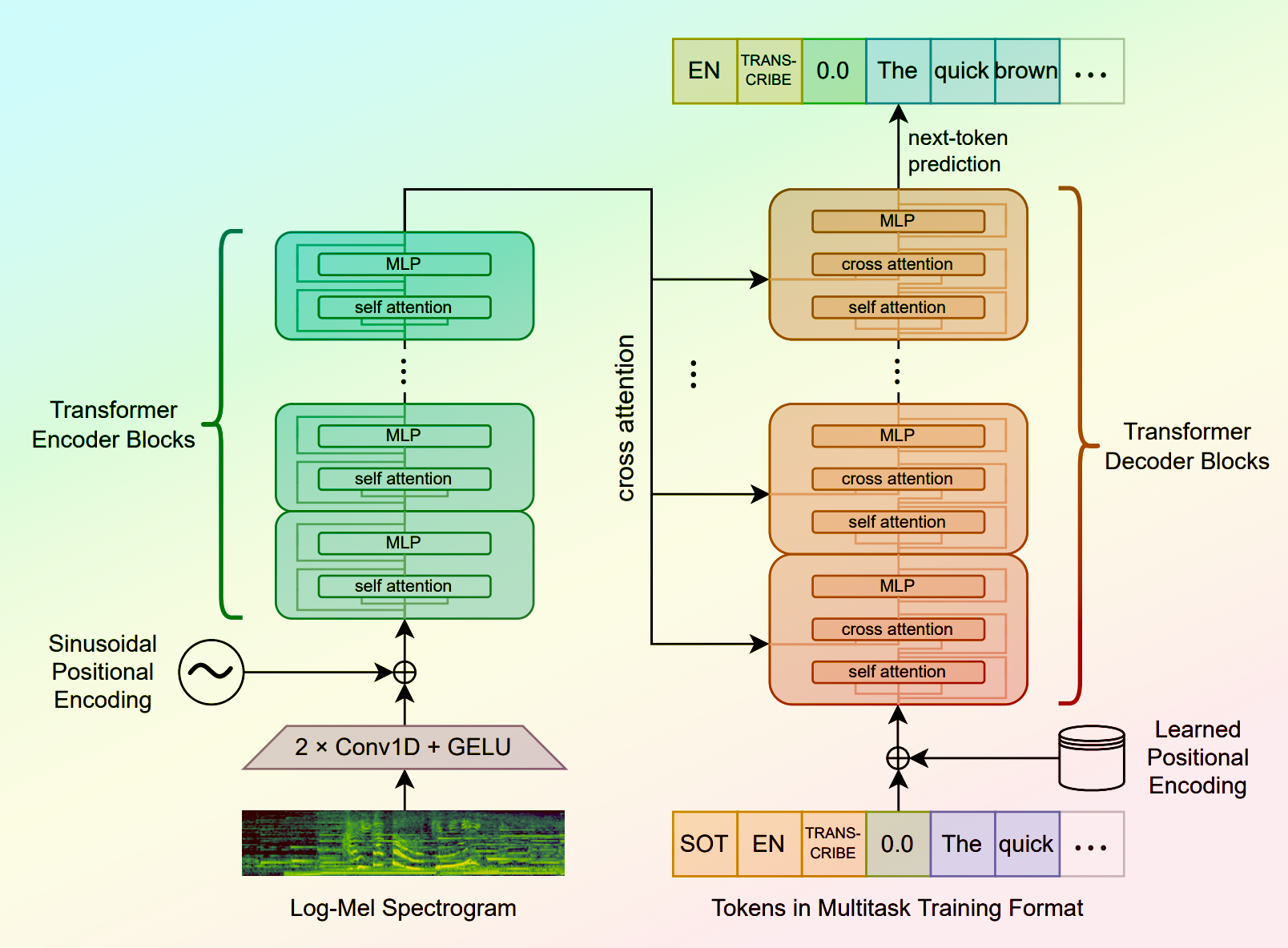parakeet-rnnt-1.1b
Maintainer: nvlabs

1

| Property | Value |
|---|---|
| Run this model | Run on Replicate |
| API spec | View on Replicate |
| Github link | View on Github |
| Paper link | View on Arxiv |
Create account to get full access
Model overview
The parakeet-rnnt-1.1b is an advanced speech recognition model developed by NVIDIA and Suno.ai. It features the FastConformer architecture and is available in both RNNT and CTC versions, making it well-suited for transcribing English speech in noisy audio environments while maintaining accuracy in silent segments. This model outperforms the popular OpenAI Whisper model on the Open ASR Leaderboard, reclaiming the top spot for speech recognition accuracy.
Model inputs and outputs
Inputs
- audio_file: The input audio file to be transcribed by the ASR model, in a supported audio format.
Outputs
- Output: The transcribed text output from the speech recognition model.
Capabilities
The parakeet-rnnt-1.1b model is capable of high-accuracy speech transcription, particularly in challenging audio environments. It has been trained on a diverse 65,000-hour dataset, enabling robust performance across a variety of use cases. Compared to the OpenAI Whisper model, the parakeet-rnnt-1.1b achieves lower Word Error Rates (WER) on benchmarks like AMI, Earnings22, Gigaspeech, and Common Voice 9.
What can I use it for?
The parakeet-rnnt-1.1b model is designed for precision ASR tasks in voice recognition and transcription, making it suitable for a range of applications such as voice-to-text conversion, meeting minutes generation, and closed captioning. It can be integrated into the NeMo toolkit for a broader set of use cases. However, users should be mindful of data privacy and potential biases in speech recognition, ensuring fair and responsible use of the technology.
Things to try
Experimenting with the parakeet-rnnt-1.1b model in various audio scenarios, such as noisy environments or recordings with silent segments, can help evaluate its performance and suitability for specific use cases. Additionally, testing the model's accuracy and efficiency on different benchmarks can provide valuable insights into its capabilities.
This summary was produced with help from an AI and may contain inaccuracies - check out the links to read the original source documents!
Related Models

whisper

30.6K
Whisper is a general-purpose speech recognition model developed by OpenAI. It is capable of converting speech in audio to text, with the ability to translate the text to English if desired. Whisper is based on a large Transformer model trained on a diverse dataset of multilingual and multitask speech recognition data. This allows the model to handle a wide range of accents, background noises, and languages. Similar models like whisper-large-v3, incredibly-fast-whisper, and whisper-diarization offer various optimizations and additional features built on top of the core Whisper model. Model inputs and outputs Whisper takes an audio file as input and outputs a text transcription. The model can also translate the transcription to English if desired. The input audio can be in various formats, and the model supports a range of parameters to fine-tune the transcription, such as temperature, patience, and language. Inputs Audio**: The audio file to be transcribed Model**: The specific version of the Whisper model to use, currently only large-v3 is supported Language**: The language spoken in the audio, or None to perform language detection Translate**: A boolean flag to translate the transcription to English Transcription**: The format for the transcription output, such as "plain text" Initial Prompt**: An optional initial text prompt to provide to the model Suppress Tokens**: A list of token IDs to suppress during sampling Logprob Threshold**: The minimum average log probability threshold for a successful transcription No Speech Threshold**: The threshold for considering a segment as silence Condition on Previous Text**: Whether to provide the previous output as a prompt for the next window Compression Ratio Threshold**: The maximum compression ratio threshold for a successful transcription Temperature Increment on Fallback**: The temperature increase when the decoding fails to meet the specified thresholds Outputs Transcription**: The text transcription of the input audio Language**: The detected language of the audio (if language input is None) Tokens**: The token IDs corresponding to the transcription Timestamp**: The start and end timestamps for each word in the transcription Confidence**: The confidence score for each word in the transcription Capabilities Whisper is a powerful speech recognition model that can handle a wide range of accents, background noises, and languages. The model is capable of accurately transcribing audio and optionally translating the transcription to English. This makes Whisper useful for a variety of applications, such as real-time captioning, meeting transcription, and audio-to-text conversion. What can I use it for? Whisper can be used in various applications that require speech-to-text conversion, such as: Captioning and Subtitling**: Automatically generate captions or subtitles for videos, improving accessibility for viewers. Meeting Transcription**: Transcribe audio recordings of meetings, interviews, or conferences for easy review and sharing. Podcast Transcription**: Convert audio podcasts to text, making the content more searchable and accessible. Language Translation**: Transcribe audio in one language and translate the text to another, enabling cross-language communication. Voice Interfaces**: Integrate Whisper into voice-controlled applications, such as virtual assistants or smart home devices. Things to try One interesting aspect of Whisper is its ability to handle a wide range of languages and accents. You can experiment with the model's performance on audio samples in different languages or with various background noises to see how it handles different real-world scenarios. Additionally, you can explore the impact of the different input parameters, such as temperature, patience, and language detection, on the transcription quality and accuracy.
Updated Invalid Date
🛸
parakeet-rnnt-1.1b

98
The parakeet-rnnt-1.1b is an ASR (Automatic Speech Recognition) model developed jointly by the NVIDIA NeMo and Suno.ai teams. It uses the FastConformer Transducer architecture, which is an optimized version of the Conformer model with 8x depthwise-separable convolutional downsampling. This XXL model has around 1.1 billion parameters and can transcribe speech in lower case English alphabet with high accuracy. The model is similar to other high-performing ASR models like Canary-1B, which also uses the FastConformer architecture but supports multiple languages. In contrast, the parakeet-rnnt-1.1b is focused solely on English speech transcription. Model Inputs and Outputs Inputs 16000 Hz mono-channel audio (WAV files) Outputs Transcribed speech as a string for a given audio sample Capabilities The parakeet-rnnt-1.1b model demonstrates state-of-the-art performance on English speech recognition tasks. It was trained on a large, diverse dataset of 85,000 hours of speech data from various public and private sources, including LibriSpeech, Fisher Corpus, Switchboard, and more. What Can I Use It For? The parakeet-rnnt-1.1b model is well-suited for a variety of speech-to-text applications, such as voice transcription, dictation, and audio captioning. It could be particularly useful in scenarios where high-accuracy English speech recognition is required, such as in media production, customer service, or educational applications. Things to Try One interesting aspect of the parakeet-rnnt-1.1b model is its ability to handle a wide range of audio inputs, from clear studio recordings to noisier real-world audio. You could experiment with feeding it different types of audio samples and observe how it performs in terms of transcription accuracy and robustness. Additionally, since the model was trained on a large and diverse dataset, you could try fine-tuning it on a more specialized domain or genre of audio to see if you can further improve its performance for your specific use case.
Updated Invalid Date

parler-tts

4.2K
parler-tts is a lightweight text-to-speech (TTS) model developed by cjwbw, a creator at Replicate. It is trained on 10.5K hours of audio data and can generate high-quality, natural-sounding speech with controllable features like gender, background noise, speaking rate, pitch, and reverberation. parler-tts is related to models like voicecraft, whisper, and sabuhi-model, which also focus on speech-related tasks. Additionally, the parler_tts_mini_v0.1 model provides a lightweight version of the parler-tts system. Model inputs and outputs The parler-tts model takes two main inputs: a text prompt and a text description. The prompt is the text to be converted into speech, while the description provides additional details to control the characteristics of the generated audio, such as the speaker's gender, pitch, speaking rate, and environmental factors. Inputs Prompt**: The text to be converted into speech. Description**: A text description that provides details about the desired characteristics of the generated audio, such as the speaker's gender, pitch, speaking rate, and environmental factors. Outputs Audio**: The generated audio file in WAV format, which can be played back or further processed as needed. Capabilities The parler-tts model can generate high-quality, natural-sounding speech with a range of customizable features. Users can control the gender, pitch, speaking rate, and environmental factors of the generated audio by carefully crafting the text description. This allows for a high degree of flexibility and creativity in the generated output, making it useful for a variety of applications, such as audio production, virtual assistants, and language learning. What can I use it for? The parler-tts model can be used in a variety of applications that require text-to-speech functionality. Some potential use cases include: Audio production**: The model can be used to generate natural-sounding voice-overs, narrations, or audio content for videos, podcasts, or other multimedia projects. Virtual assistants**: The model's ability to generate speech with customizable characteristics can be used to create more personalized and engaging virtual assistants. Language learning**: The model can be used to generate sample audio for language learning materials, providing learners with high-quality examples of pronunciation and intonation. Accessibility**: The model can be used to generate audio versions of text content, improving accessibility for individuals with visual impairments or reading difficulties. Things to try One interesting aspect of the parler-tts model is its ability to generate speech with a high degree of control over the output characteristics. Users can experiment with different text descriptions to explore the range of speech styles and environmental factors that the model can produce. For example, try using different descriptors for the speaker's gender, pitch, and speaking rate, or add details about the recording environment, such as the level of background noise or reverberation. By fine-tuning the text description, users can create a wide variety of speech samples that can be used for various applications.
Updated Invalid Date

neon-tts

71
The neon-tts model is a Mycroft-compatible Text-to-Speech (TTS) plugin developed by Replicate user awerks. It utilizes the Coqui AI Text-to-Speech library to provide support for a wide range of languages, including all major European Union languages. As noted by the maintainer awerks, the model's performance is impressive, with real-time factors (RTF) ranging from 0.05 on high-end AMD/Intel machines to 0.5 on a Raspberry Pi 4. This makes the neon-tts model well-suited for a variety of applications, from desktop assistants to embedded systems. Model inputs and outputs The neon-tts model takes two inputs: a text string and a language code. The text is the input that will be converted to speech, and the language code specifies the language of the input text. The model outputs a URI representing the generated audio file. Inputs text**: The text to be converted to speech language**: The language of the input text, defaults to "en" (English) Outputs Output**: A URI representing the generated audio file Capabilities The neon-tts model is a powerful tool for generating high-quality speech from text. It supports a wide range of languages, making it useful for applications targeting international audiences. The model's impressive performance, with real-time factors as low as 0.05, allows for seamless integration into a variety of systems, from desktop assistants to embedded devices. What can I use it for? The neon-tts model can be used in a variety of applications that require text-to-speech functionality. Some potential use cases include: Virtual assistants: Integrate the neon-tts model into a virtual assistant to provide natural-sounding speech output. Accessibility tools: Use the model to convert written content to speech, making it more accessible for users with visual impairments or reading difficulties. Multimedia applications: Incorporate the neon-tts model into video, audio, or gaming applications to add voice narration or spoken dialogue. Educational resources: Create interactive learning materials that use the neon-tts model to read aloud text or provide audio instructions. Things to try One interesting aspect of the neon-tts model is its ability to support a wide range of languages, including less common ones like Irish and Maltese. This makes it a versatile tool for creating multilingual applications or content. You could experiment with generating speech in various languages to see how the model handles different linguistic structures and phonologies. Another interesting feature of the neon-tts model is its low resource requirements, allowing it to run efficiently on devices like the Raspberry Pi. This makes it a compelling choice for embedded systems or edge computing applications where performance and portability are important.
Updated Invalid Date